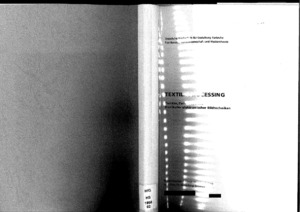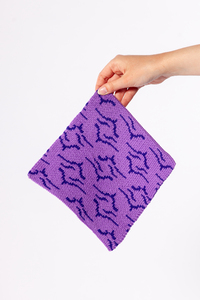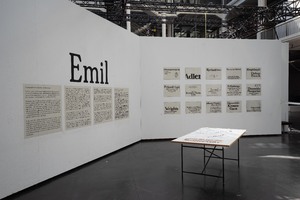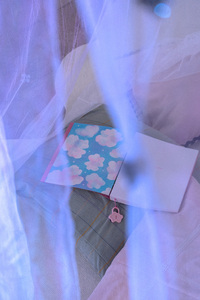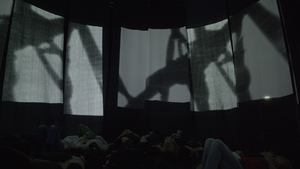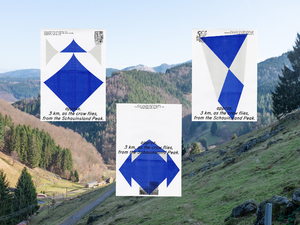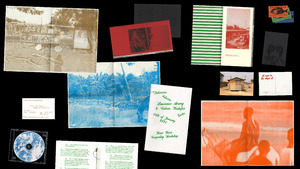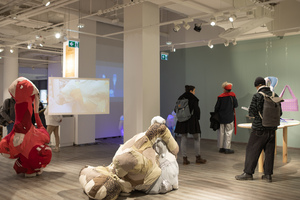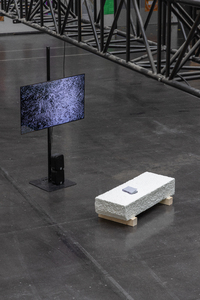Cooking Care
Sibling sets (40)Show all relations
This set is related to the same sets as the selected set.
40 Items
- Page 1 of 4
Textile Processing
- Title
- Textile Processing
- Subtitle
- Punkte, Zeilen, Spalten; Vorläufer elektronischer Bildtechniken
- Author
- Description (de)
- “Die Ähnlichkeiten von Geweben, Mustervorlagen und heutigen Rasterbildern sind eklatant. In einer Genese der technischen Bilder kann das Gewebe als Exemplarfall und Vorreiter aller technisch-elektronischer Bilder gelten.”
“Die ersten Bilder, die von ihrem Bildkörper abgelöst wurden, bestanden aus einem Stapel gelochter Karten für die Verwendung im Jacquardwebstuhl. Der Bildcode ist hier noch begreifbar, das Bild, wenn es aus dem Stapel dieser Karten gewoben wird, ein textil-taktiles Produkt. Patricia Wallers Needle-Works zeigen die Leerstelle heutiger Bildmaschinen auf, wo Bilder auf Monitoren erscheinen, um im nächsten Moment schon wieder durch den nächsten (Netzhaut-) Eindruck ausgetauscht zu werden.”
- “Die Ähnlichkeiten von Geweben, Mustervorlagen und heutigen Rasterbildern sind eklatant. In einer Genese der technischen Bilder kann das Gewebe als Exemplarfall und Vorreiter aller technisch-elektronischer Bilder gelten.”
- Description (en)
- “The similarities between fabrics, patterns and today's raster images are striking. In the genesis of technical images, the fabric can be regarded as an exemplary case and forerunner of all technical-electronic images.”
“The first images that were detached from their image body consisted of a stack of perforated cards for use in the Jacquard loom. The image code is still comprehensible here, the image, when woven from the pile of these cards, is a textile-tactile product. Patricia Waller's needle works show the blank space of today's image machines, where images appear on monitors only to be replaced by the next (retinal) impression in the very next moment.”
- “The similarities between fabrics, patterns and today's raster images are striking. In the genesis of technical images, the fabric can be regarded as an exemplary case and forerunner of all technical-electronic images.”
- Category
- Type of project / creative work
- Keywords
- Date
- 02.11.1998
- Language
- Location: institution
- City
- Title
- Textile Processing
- Projektleiter/in
- Semester
- Program of Study
- Type of graduation project
- Archive signature
- HfG HS 1998 02
- External archive
- Imported on
- 11.01.2024
- Parent sets
- 0
- Set is related to
- 0 2
Path Tiles
- Title
- Path Tiles
- Title (en)
- Path Tiles
- Subtitle
- Knitting Coordinates into Patterns
- Subtitle of the project/work (en)
- Knitting Coordinates into Patterns
- Author
- Description (de)
- Unsere Bewegungen können wie eine Performance begriffen werden, wie etwas Flüchtiges, das nur im Moment existiert und nach der Vollendung weder sichtbar noch fassbar ist. Nur die Erinnerungen an das Erlebte bleiben als Spuren der Bewegung in unserem Geist erhalten. Path Tiles nutzt GPS-Daten, um diese besonderen Momente individueller Erfahrung einzufangen und in Form von Mustern in die physische Welt des sicht- und tastbaren Textils zu übertragen. Es entsteht eine tiefe Bindung zwischen Mensch und Objekt.
Jedes Muster steht für eine Reise, für eine Erfahrung. Dabei ist es egal, ob es sich um einen Spaziergang in der Natur, eine Reise in ein fernes Land oder einen wiederkehrenden Weg des Alltags handelt. Die daraus entstehenden Muster erzählen von den Gefühlen und Begegnungen, von dem Gesehenen und dem Erlebten und erinnern uns an das, was uns ausmacht.
Mit der Path Tiles Website habe ich ein Werkzeug entwickelt, um diese Reisen in Form von GPS-Daten in strickbare Muster zu verwandeln. Ich habe die Website so gestaltet, dass die Ästhetik des Musters durch zusätzliche Verschiebung, Verzerrung und Spiegelung individualisiert werden kann. Dies stellt außerdem sicher, dass Menschen mit der gleichen Strecke trotzdem persönliche Muster erstellen können. Das entstandene Muster wird dann in Form eines gestricktes Objekts zum Leben erweckt und wird zur materialisierten persönlichen Erfahrung. Durch die Einbeziehung des Nutzers in den Gestaltungsprozess entsteht eine weitere Ebene der Bindung zwischen Mensch und Objekt.
Für das Diplom habe ich exemplarisch fünf Objekte gestaltet, die mit diesen Mustern personalisiert werden können. Das Design der Objekte konzentriert sich darauf, das Reisen oder das „unterwegs sein“ in verschiedenen Situationen zu erleichtern. In diesem Prozess ist ein Schal mit Taschen, ein Umhang, der gleichzeitig als Decke genutzt werden kann, eine Tasche, die zugleich ein Kissen ist, eine Balaklava mit Ohrenschützern und ein Nackenkissen mit Rückenstütze und Taschen in den verlängerten Seitenteilen entstanden.
Für die finale Herstellung der Objekte haben fünf Personen die GPS-Daten verschiedener Routen verwendet um ihre persönlichen Muster auf der Path Tiles Website zu erstellen. Jedes der Objekte wurde zu einer Person, einer Reise, einem Muster zugeordnet und entsprechend produziert. Die fertigen Objekte sind die materialisierten Erfahrungen und Erinnerungen dieser Menschen.
Begleitend zu dieser Arbeit habe ich mit der Sammlung von Reisen in Form von Geschichten und Mustern begonnen. Hierbei ist ein kleines Booklet entstanden, das die Beiträge von 19 Menschen beinhaltet. Sie alle haben eine Erinnerung von einer Reise in Form von Text und Muster mit mir geteilt.
- Unsere Bewegungen können wie eine Performance begriffen werden, wie etwas Flüchtiges, das nur im Moment existiert und nach der Vollendung weder sichtbar noch fassbar ist. Nur die Erinnerungen an das Erlebte bleiben als Spuren der Bewegung in unserem Geist erhalten. Path Tiles nutzt GPS-Daten, um diese besonderen Momente individueller Erfahrung einzufangen und in Form von Mustern in die physische Welt des sicht- und tastbaren Textils zu übertragen. Es entsteht eine tiefe Bindung zwischen Mensch und Objekt.
- Description (en)
- Movement is like a performance, something momentous becoming invisible and untouchable as soon as it is complete. Only the memories of the experience remain as traces of the movement in our minds. Path Tiles captures these valuable moments of individual experiences and transfers them into the physical world of visible and tactile textiles, creating a deep relationship between person and object.
Each pattern represents a journey, an experience. It doesn't matter whether it's a walk in nature, a trip to a distant country, or a repeating path in everyday life. The resulting patterns tell of the emotions evoked by landscapes, the lessons learned along the way and the power of the journey to shape our lives.
With the Path Tiles website, I have developed a tool to transform these journeys into knitable patterns using GPS data. I designed the website so that the aesthetics of the pattern can be individualized through shifting, distorting, and mirroring. This ensures that even people with the same route can create personal patterns. The resulting pattern is then brought to life in the form of a knitted object, becoming a materialized personal experience. By involving the user in the design process, an additional layer of connection between person and object is created.
For my diploma, I have designed five objects that can be personalized with these patterns. The design of these objects focuses on making travelling or being "on the go" more comfortable. This process has resulted in the creation of a scarf with pockets, a cape that can also be used as a blanket, a bag that doubles as a pillow, a balaclava with ear cushions, and a neck pillow with back support and pockets in the extended side parts.
For the final production of the objects, five people used the GPS data of different routes to create their personal patterns on the Path Tiles website. Each of the objects was assigned to a person, a journey, a pattern, and then produced accordingly. The finished objects are the materialized experiences and memories of these people.
Accompanying this work, I have started collecting journeys in the form of stories and patterns. This resulted in a small booklet that includes contributions from 19 people. They all shared a memory of a journey in the form of text and pattern with me.
- Movement is like a performance, something momentous becoming invisible and untouchable as soon as it is complete. Only the memories of the experience remain as traces of the movement in our minds. Path Tiles captures these valuable moments of individual experiences and transfers them into the physical world of visible and tactile textiles, creating a deep relationship between person and object.
- Category
- Type of project / creative work
- Keywords
- Date
- April 2024
- Contributors
- Thanks to
- Material
- Location: institution
- Internetlinks
- Remarks
- Die Diplomarbeit wurde von Prof. Wieki Somers und Prof. Céline Condorelli betreut.
- Title
- Path Tiles
- Projektleiter/in
- Semester
- Program of Study
- Type of graduation project
- Imported on
- 28.05.2024
- Parent sets
- 3
- Set is related to
- 0 42
Versuche zu überschreiben
- Title
- Versuche zu überschreiben
- Title (en)
- Attempts to rewrite
- Subtitle
- Ausstellung mit drei Videoarbeiten: Auf dem Weg zum Bahnhof, Prolog: Im Zoo, Germania Girl - Konzert im Schloss!
- Subtitle of the project/work (en)
- Exhibition with three video works: On the way to the station, Prologue: In the zoo, Germania Girl - Concert in the castle!
- Author
- Description (de)
- Obszön, nerdy und aus Japan: Anime im Fernsehen zu schauen galt in vielen Haushalten in Deutschland als verrufen. Diese Rezeption von Anime entspricht zugleich den exotisierenden Stereotypen, die der (vorgeblich gesittete) Westen auf Japan projiziert. In ihrer Diplomarbeit nutzt Miki Feller Anime als Medium, um über anti-asiatischen Rassismus zu sprechen. Entstanden sind drei Videoarbeiten, die sie in ihrer Ausstellung „Versuche zu überschreiben“ gezeigt hat. Jedes Video erzählt eine eigene Geschichte, die in Karlsruhe spielt, unter anderem am Bahnhof, am Zoo und am Schloss. Es sind Versuche, eine vorherrschend weiße Umgebung zu beschreiben, sich dazu zu positionieren und davon zu distanzieren.
Die Videos wurden in Zusammenarbeit mit folgenden Personen realisiert und ausgestellt: „Versuche zu überschreiben“ mit Max Mandery (Dramaturgische Beratung), Bruno Jacoby (Grafik), Leia Walz (Ausstellungsgestaltung), Jaya Demmer (Textil), Johannes Thimm und Lina Determann (Rampe) / „Auf dem Weg zum Bahnhof“ mit Bruno Jacoby (Grafik) / „Prolog: Im Zoo“ mit Sophia Stadler (Storyboard, Schnitt & Fotos) / „Germania Girl – Konzert im Schloss!“ mit Max Mandery (Dramaturgische Beratung), Bruno Jacoby (Grafik), Yun-Wen Liu (Fotos & Farbkorrektur), Vanessa Bosch (Musik), Ricarda Fischer (Musik & Sounddesign), Meret Bhend und Paulina Mimberg (Farbkorrektur), Luise Peschko (Dialog Editing) sowie Nele Faust, Alejandra Janus, Melanie Berner, Rita Andrulyte, Nini Lü, Jörg Stegmann, Laura Haak und Josefine Scheu (Stimmen).
- Obszön, nerdy und aus Japan: Anime im Fernsehen zu schauen galt in vielen Haushalten in Deutschland als verrufen. Diese Rezeption von Anime entspricht zugleich den exotisierenden Stereotypen, die der (vorgeblich gesittete) Westen auf Japan projiziert. In ihrer Diplomarbeit nutzt Miki Feller Anime als Medium, um über anti-asiatischen Rassismus zu sprechen. Entstanden sind drei Videoarbeiten, die sie in ihrer Ausstellung „Versuche zu überschreiben“ gezeigt hat. Jedes Video erzählt eine eigene Geschichte, die in Karlsruhe spielt, unter anderem am Bahnhof, am Zoo und am Schloss. Es sind Versuche, eine vorherrschend weiße Umgebung zu beschreiben, sich dazu zu positionieren und davon zu distanzieren.
- Description (en)
- Obscene, nerdy, and from Japan: In many German households, it was forbidden to watch anime on television. This perception of anime mirrors the exoticizing stereotypes projected onto Japan by the (allegedly civilized) West. In her diploma project, Miki Feller addresses anti-Asian racism in Germany by using anime as the medium. She created three video works and showcased them in the exhibition “Versuche zu überschreiben.” Each video tells a story set in Karlsruhe, for example, at the train station, the zoo, and the castle. These videos serve as attempts to describe a predominantly white environment, to position oneself in relation to it, and to distance oneself from it.
The videos were created and presented in collaboration with the following people: "Versuche zu überschreiben" with Max Mandery (dramaturgical consultation), Bruno Jacoby (graphics), Leia Walz (exhibition design), Jaya Demmer (textile), Johannes Thimm and Lina Determann (ramp) / "Auf dem Weg zum Bahnhof" with Bruno Jacoby (graphics) / "Prolog: Im Zoo" with Sophia Stadler (storyboard, editing & photos) / "Germania Girl - Konzert im Schloss!" with Max Mandery (dramaturgical consultation), Bruno Jacoby (graphics), Yun-Wen Liu (photos & color grading), Vanessa Bosch (music), Ricarda Fischer (music & sound design), Meret Bhend and Paulina Mimberg (color grading), Luise Peschko (dialog editing) as well as Nele Faust, Alejandra Janus, Melanie Berner, Rita Andrulyte, Nini Lü, Jörg Stegmann, Laura Haak, and Josefine Scheu (voice acting).
- Obscene, nerdy, and from Japan: In many German households, it was forbidden to watch anime on television. This perception of anime mirrors the exoticizing stereotypes projected onto Japan by the (allegedly civilized) West. In her diploma project, Miki Feller addresses anti-Asian racism in Germany by using anime as the medium. She created three video works and showcased them in the exhibition “Versuche zu überschreiben.” Each video tells a story set in Karlsruhe, for example, at the train station, the zoo, and the castle. These videos serve as attempts to describe a predominantly white environment, to position oneself in relation to it, and to distance oneself from it.
- Type of project / creative work
- Keywords
- Date
- 22.09.2023 - 24.09.2023
- Contributors
- Thanks to
- Language
- Location: institution
- City
- Country
- Title
- Versuche zu überschreiben
- Projektleiter/in
- Semester
- Program of Study
- Type of graduation project
- Imported on
- 04.03.2024
- Parent sets
- 2
- Set is related to
- 0 9
Emil
- Title
- Emil
- Title (en)
- Emil
- Subtitle
- Typografie als Medium historischer Sichtbarkeit
- Subtitle of the project/work (en)
- A typographic revival reflecting historical erasure
- Author
- Description (de)
- „Emil” ist ein Diplomprojekt, das die Rolle der Typografie im Umgang mit Erinnerung, Verdrängung und historischen Brüchen untersucht. Im Mittelpunkt stehen die Lebens- und Werkgeschichten jüdischer Gestalter:innen während des Nationalsozialismus, darunter Elizabeth Friedländer und Lucian Bernhard (geb. Emil Kahn).
Ein zentrales Element des Projekts ist das Revival der Bernhard Antiqua von Lucian Bernhard. Die Schrift wurde für die zeitgenössische Nutzung digital neu interpretiert und prägt die gesamte visuelle Ebene des Projekts – von der Plakatserie über die Ausstellungsgestaltung bis hin zur Vortragspräsentation. So wird Typografie zum Untersuchungsgegenstand und zum gestalterischen Werkzeug der Erinnerung.
Für Julian Jaffé, Nachfahre einer jüdischen Familie, die im Nationalsozialismus ins Exil gezwungen wurde, ist "Emil" nicht nur ein typografisches Projekt, sondern auch ein persönlicher Akt des Erinnerns.
- „Emil” ist ein Diplomprojekt, das die Rolle der Typografie im Umgang mit Erinnerung, Verdrängung und historischen Brüchen untersucht. Im Mittelpunkt stehen die Lebens- und Werkgeschichten jüdischer Gestalter:innen während des Nationalsozialismus, darunter Elizabeth Friedländer und Lucian Bernhard (geb. Emil Kahn).
- Description (en)
- Emil is a diploma project that examines the role of typography in dealing with memory, repression and historical ruptures. It focuses on the lives and works of Jewish designers during National Socialism, including Elizabeth Friedländer and Lucian Bernhard (born Emil Kahn).
A central element of the project is the revival of Bernhard Antiqua by Lucian Bernhard. The font has been digitally reinterpreted for contemporary use and shapes the entire visual level of the project – from the poster series to the exhibition design and lecture presentation. In this way, typography becomes both the subject of investigation and a creative tool of remembrance.
For Julian Jaffé, a descendant of a Jewish family forced into exile during the Nazi era, ‘Emil’ is not only a typographic project, but also a personal act of remembrance.
- Emil is a diploma project that examines the role of typography in dealing with memory, repression and historical ruptures. It focuses on the lives and works of Jewish designers during National Socialism, including Elizabeth Friedländer and Lucian Bernhard (born Emil Kahn).
- Category
- Keywords
- Thanks to
- Technology/production/formats
- Typografie
- Title
- Emil
- Projektleiter/in
- Semester
- Program of Study
- Type of graduation project
- Imported on
- 26.06.2025
- Parent sets
- 0
- Set is related to
- 0 13
eternal girlhood
- Title
- eternal girlhood
- Subtitle
- oh my dreams
- Author
- Description (de)
- “eternal girlhood” ist eine konzeptionelle Arbeit, welche aus einer Rauminstallation und einer Publikation besteht.
Ursprünglich in den Chinesischen Pavillons des Fasanengartens in Karlsruhe installiert, wurde der Raum mit der Handlung der Publikation durch Requisiten sowie ein selbst produziertes Musikstück verknüpft.
Das Projekt ermöglicht eine Reise in eine poetische Geschichte, inspiriert von persönlichen und kulturellen Themen wie Girlhood, Coming-of-Age und Growing Pains.
Die handgebundene Publikation mit glitzerndem und geprägtem Umschlag umfasst auf ca. 100 Seiten neben Serien analoger Schwarzweiß-Fotografie farbige Mittelformat-Fotos, begleitet von analogen Schnappschüssen und Illustrationen im Riso-Druck.
Zwischen Fotoserien und Illustrationen sind Songtexte sowie Skriptfragmente und Gedichte eingestreut, in Referenz zu Filmsequenzen aus Coming-of-Age-Geschichten. Es ergibt sich die zeitlose Skizze eines Mädchens, das Teil einer innig verbundenen Mädchengruppe ist.
Transparente Drucke von drei Mittelformat-Fotografien werden vom Fensterlicht erleuchtet und symbolisieren in Zusammenhang mit dem Buch unterschiedliche Kapitel der Geschichte.
Unter einem Baldachin, umgeben von funkelnd tanzenden Schmetterlingen, können Besucher*innen in diese Welt eintauchen und sind eingeladen, für einen Moment Teil von „eternal girlhood“ zu sein, fernab der Echtzeit.
- “eternal girlhood” ist eine konzeptionelle Arbeit, welche aus einer Rauminstallation und einer Publikation besteht.
- Description (en)
- “eternal girlhood“ is a conceptional artwork, blending a publication with its installation space.
Initially installed in the Chinese pavillons of the Fasanengarten in Karlsruhe, the space was connected to the story of the book through props and a musical sound score.
The project offers a journey into a poetic story, inspired by personal and cultural ideas on girlhood, coming of age and growing pains.
Handbound, wrapped in a glittery embossed dustcover, the publication features around 100 pages with multiple series of black and white film photography, medium format shots underlined by analog snapshots and Riso printed Illustrations. In between the chapters of photography and Illustrations, lyrics, fragments of script and poems are inserted in reference to movie sequences from coming of age stories. A timeless profile of a girl being part of girlhood and a deeply connected friendship is created.
Transparent prints of three medium format photos are illuminated by the windows’ natural light and symbolize different chapters of the story in combination with the book.
Underneath a canopy, surrounded by sparkling dancing butterflies, visitors can dive into this world and are invited to become part of “eternal girlhood“, away from modern reality.
- “eternal girlhood“ is a conceptional artwork, blending a publication with its installation space.
- Category
- Type of project / creative work
- Keywords
- Date
- 05.07.2024
- Contributors
- Thanks to
- Language
- Material
- Technology/production/formats
- Risographie, Digitaldruck, Mediumformat-Fotografie, Schreibmaschine, Laser, Prägung
- Dimensions
- Fläche: ca. 5m x 5m, Höhe der Aufhängung ca. 3m
- Location: institution
- Location
- Chinesische Pavilions des Fasanengarten
- City
- Country
- Participating institution(s)
- Title
- eternal girlhood
- Projektleiter/in
- Semester
- Program of Study
- Type of graduation project
- Imported on
- 05.11.2024
- Parent sets
- 2
- Set is related to
- 0 21
Manchmal ist Schmerz ganz leise
- Title
- Manchmal ist Schmerz ganz leise
- Title (en)
- Sometimes pain is very quiet
- Author
- Description (de)
- „Manchmal ist Schmerz ganz leise“ ist eine immersive, autobiographische Hörstück-Installation, die den stillen und oft unsichtbaren Kampf mit einer schweren, namenlosen Krankheit in den Mittelpunkt stellt. Das Werk hinterfragt, was es bedeutet, in einer leistungsorientierten Gesellschaft plötzlich nicht mehr zu "funktionieren". Es geht den Ängsten, der Scham und dem tief empfundenen Gefühl des Versagens nach, das oft mit chronischer Krankheit einhergeht – Gefühle, die Betroffene selten teilen. Das Hörspiel verleiht einer Stimme Ausdruck, die für viele spricht und Einblicke in eine Realität gibt, die oft im Verborgenen bleibt.
- Description (en)
- ‘Sometimes pain is very quiet’ is an immersive, autobiographical audio play installation that focuses on the silent and often invisible battle with a serious, nameless illness. The work questions what it means to suddenly no longer ‘function’ in a performance-orientated society. It explores the fears, the shame and the deeply felt sense of failure that often accompanies chronic illness - feelings that are rarely shared by those affected. The radio play gives expression to a voice that speaks for many and provides insights into a reality that often remains hidden.
- Category
- Type of project / creative work
- Keywords
- Date
- 30.10.2024
- Contributors
- Thanks to
- Finn Baygan
- Daniel Berwanger
- Pauline Cemeris
- Filipa Cesar
- Mark Patrick Damian
- Charlotte Eifler
- Flora Güldenpfennig
- Tobias Keilbach
- Eisenhart Keimeyer
- Alexander Knoppik
- Yael Kolb
- Isabelle Konrad
- Julian Kuf
- Barbara Kuon
- Josephine Leicht
- Laura Morcillo
- Ilja Morgenstern
- Sebastian Schäfer
- Sebastian Schönfeld
- Lorenz Schwarz
- Quirin Thalhammer
- Alexander Thelen
- Riemschneider Stiftung
- Zeitbild Lab
- Language
- Material
- Technology/production/formats
- 4-Kanal-Audio/360° Projection Mapping
- Dimensions
- Länge: 8m, Breite: 8m, Höhe: 6,50m
- Duration
- 30min
- Location: institution
- Location
- Großes Studio
- City
- Country
- Title
- Manchmal ist Schmerz ganz leise
- Projektleiter/in
- Semester
- Program of Study
- Type of graduation project
- Imported on
- 17.04.2025
- Parent sets
- 0
- Set is related to
- 1 5
approx. 3km, as the crow flies, from the Schauinsland Peak.
- Title
- approx. 3km, as the crow flies, from the Schauinsland Peak.
- Author
- Description (de)
- "approx., 3km, as the crow flies, from the Schauinsland Peak." ist ein Zitat aus der Wegbeschreibung zum Zentralen Bergungsort der Bundesrepublik Deutschland (ZBO) aus dem Internationalen Register der Kulturgüter unter besonderem Schutz der UNESCO. Die Wegbeschreibung führt zum Barbarastollen, einem ehemaligen Erzbergbaustollen im Hintertal, nahe der Gemeinde Oberried im Schwarzwald.
Die Ausstellung versammelt Material in verschiedenen Formen, die den Barbarastollen und damit verbundene Aspekte erforschen. Anhand von Artefakten, die bei mehreren Besuchen im und um den Stollen herum gefunden wurden – Fotos, Geschichten, Zeitungsartikeln, E-Mails, Archivdokumenten, Ton- und Videoaufnahmen –, untersucht die Ausstellung, wie das Archiv im Stollen funktioniert und warum es noch existiert.
Themen wie Sicherheit, atomare Bedrohung, Hierarchien in der Archivauswahl, Langzeitbotschaften, Atomsemiotik, Friedensbewegung in Süddeutschland in den 80er Jahren werden verhandelt. Durch die Zusammenführung verschiedener Perspektiven auf die Idee eines zentralen Bergungsortes wurde ein Raum geschaffen, der die Besucher dazu anregt, sich kritisch mit den angesprochenen Themen auseinanderzusetzen.
- "approx., 3km, as the crow flies, from the Schauinsland Peak." ist ein Zitat aus der Wegbeschreibung zum Zentralen Bergungsort der Bundesrepublik Deutschland (ZBO) aus dem Internationalen Register der Kulturgüter unter besonderem Schutz der UNESCO. Die Wegbeschreibung führt zum Barbarastollen, einem ehemaligen Erzbergbaustollen im Hintertal, nahe der Gemeinde Oberried im Schwarzwald.
- Description (en)
- "approx., 3km, as the crow flies, from the Schauinsland Peak." is a quote from the route description to the Central Salvation Site of the Federal Republic of Germany (ZBO) from the UNESCO International Register of Cultural Property under Special Protection. The route description leads to Barbarastollen, a former ore mining tunnel in Hintertal, near the municipality of Oberried in the Black Forest.
The exhibition is gathering material of different forms researching the site of the Barbarastollen. Through several site visits inside and around the mine, photographs, stories, newspaper articles, e-mails, archival documents, sound recordings and videos investigate on how the archive works and why it still exists touching on topics of safety, nuclear threat, hierarchies in archive selections, long-time messages, atom semiotics, the peace- movement in south Germany in the 80s.
Through bringing together different perspectives on the idea of the central Salvation Site a room was created to encourage visitors to critically from their own idea on the topics addressed.
- "approx., 3km, as the crow flies, from the Schauinsland Peak." is a quote from the route description to the Central Salvation Site of the Federal Republic of Germany (ZBO) from the UNESCO International Register of Cultural Property under Special Protection. The route description leads to Barbarastollen, a former ore mining tunnel in Hintertal, near the municipality of Oberried in the Black Forest.
- Category
- Type of project / creative work
- Keywords
- Date
- 05.07.2024
- Contributors
- Language
- Material
- Location: institution
- Location
- Großes Studio
- City
- Country
- Title
- approx. 3km, as the crow flies, from the Schauinsland Peak.
- Projektleiter/in
- Semester
- Program of Study
- Type of graduation project
- Imported on
- 04.11.2024
- Parent sets
- 2
- Set is related to
- 0 19
A man in the shape of...
- Title
- A man in the shape of...
- Title (en)
- A man in the shape of...
- Author
- Description (de)
- „A man in the shape of...“ ist eine von Calvin Kudufia realisierte Ausstellung, die Februar 2024 im Rahmen seines Diploms stattfand. In der Ausstellung beschäftigt sich Kudufia mit der metaphorischen Praxis des Sammelns und Verdichtens: „gathering time and binding it“, wie es die dänische Dichterin Inger Christensen in ihrem Gedicht „Alphabet“ (1981) formuliert hat. Scheinbar unzusammenhängende ‚Dinge‘ werden im Gedicht zusammengetragen und durch die einfache Verwendung eines einzelnen Wortes, des "Existierens" in Zusammenhang gebracht und bedeutsam gemacht. Allein die Geste des Zusammentragen und Benennens verstärkt ihre symbolische Kraft.
Durch einen losen Kontaktpunkt in 2019 begann Kudufias Recherche an der Sepulkralkultur der fantasy coffins, einem traditionellen Kunsthandwerk der Ga-Ethnie in Ghana. Die individuell gestalteten Särge folgen einem mündlich überlieferten Bildindex und sind stellvertretende Gefäße für das ins Jenseits übertretende Leben. Die ‚fantasy coffins‘ verhüllen nicht nur den physischen Körper, ihre Hülle trägt konkrete Spuren der in ihnen gefassten Existenz.
Wie alle Gefäße schirmen die ‚fantasy coffins‘ ihren Inhalt vor den Blicken der Umgebung ab. Im selben Moment dienen sie als repräsentativer Körper des Verstorbenen. Die Suche nach dem richtig geformten Gefäß, sei es ein Weidenkorb für Früchte, ein Buch für Worte oder im Fall der ‚fantasy coffins‘ ein Fischernetz für Fischer, stellt die Suche nach Signifikanz des eigenen Lebens dar: eine treffende Metapher für die Odyssee des Lebens.
In seiner Arbeit „A man in the shape of...“ macht Kudufia sein väterliches Haus in Tema (Ghana) zum physischen Ausgangspunkt seiner Recherche. In Form einer trans-medialen Erzählung wird dessen Essenz eingefangen und greifbar gemacht. Poetische Artefakte und Beobachtungen aus dem Alltag in Ghana werden sorgfältig arrangiert und dienen als Verdinglichung von Zeit. Sie dienen als greifbare Säulen von Kudufias Zeit in Ghana.
„A man in the shape of...“ trägt der angeborenen Sehnsucht nach einer konkreten geografischen Verankerung Rechnung. Kudufia nutzt die gesamte Ausstellung als metaphorischen Fingerzeig auf einen Ort auf der Landkarte.
In Form einer Audioübertragung, einer speziellen Sitzposition auf der Nachbildung eines traditionellen Hockers, referentiellen Bautechniken und einer Dreikanal-Videoinstallation wird diese geografische Verankerung konkret vermittelt. Durch die Untersuchung der Rolle von Ritualen bei der Gestaltung unseres Zugehörigkeitsgefühls, inspiriert durch die philosophischen Überlegungen von Byung Chul Han, bietet die Ausstellung ein Fenster zu einer Kultur, die gleichzeitig vertraut und fremd ist.
Im Mittelpunkt der Ausstellung steht eine Videoinstallation, die in sieben Abschnitte unterteilt ist. Die Aufteilung bezieht sich auf die Tradition der „one-week observation“ und beschreibt jeweils eine Facette von Kudufias persönlicher Reise. Das Video wird begleitet von einem Musikstück der ghanaischen Theatermacherin Edufa T. Sutherland, das mit der Unterstützung des Cellisten Ben Grocock gespielt und aufgenommen wurde. Das Video lässt Kudufias Erinnerungen, Fiktionen und Realitäten verschwimmen und vermischt dabei die Identitäten von Kudufia mit denen seines Vaters und Großvaters und lässt so ein komplexes Netz aus Zugehörigkeiten entstehen.
Eine Publikation, die integraler Bestandteil der Ausstellung ist, bedient sich der Form eines Gefäßes. Eine bedruckte Archivbox sammelt Kudufias Spuren auf seiner Suche nach den ‚fantasy coffins‘ und wird durch eine Hand voll ephemeraler Druckprodukte und Publikationen zum Dokumentationsapparat. Im Mittelpunkt der Archivbox steht ein Interview, zwischen Kudufia und dem Sargmacher Lawrence Anang in dessen Werkstatt in Teshie. Die einzige textliche Spur, die eine klare Verbindung zur Geschichte der Särge herstellt.
Das hölzerne Fundament einer nachgebauten Hütte dient als Sammelpunkt der Ausstellung und ermöglicht die Verbindung zwischen Druckerzeugnissen, Audio, Artefakten und den Betrachtenden. Die Kombination aus gesammeltem haptischen Material und audiovisuellen Arbeiten setzt sich zu einer transmedialen Collage zusammen, in der Kudufia die Geschichte seiner Verwurzelung auf intime Weise erzählt.
- „A man in the shape of...“ ist eine von Calvin Kudufia realisierte Ausstellung, die Februar 2024 im Rahmen seines Diploms stattfand. In der Ausstellung beschäftigt sich Kudufia mit der metaphorischen Praxis des Sammelns und Verdichtens: „gathering time and binding it“, wie es die dänische Dichterin Inger Christensen in ihrem Gedicht „Alphabet“ (1981) formuliert hat. Scheinbar unzusammenhängende ‚Dinge‘ werden im Gedicht zusammengetragen und durch die einfache Verwendung eines einzelnen Wortes, des "Existierens" in Zusammenhang gebracht und bedeutsam gemacht. Allein die Geste des Zusammentragen und Benennens verstärkt ihre symbolische Kraft.
- Description (en)
- "A man in the shape of..." is an exhibition realised by Calvin Kudufia, which took place in February 2024 as part of his diploma. In the exhibition, Kudufia deals with the metaphorical practice of "gathering time and binding it", as formulated by the Danish poet Inger Christensen. Through a trans-medial narration, the exhibition aims to capture the essence of his father's home in Tema (Ghana) and to make it tangible by carefully compiling poetic artefacts from the observed everyday life in Ghana.
Kudufia's research began with the so-called fantasy coffins, a traditional handicraft practiced by the Ga people of Ghana. The individually designed coffins follow an oral figurative index and are emblematic vessels for life passing into the afterlife. Not only do they conceal the physical body, but their shell bears imprints of the existence that preceded death. To give an example, the vessel of a fisherman might take the form of a boat or fishing net.
Similar to all vessels, they shield their content from its surroundings, simultaneously serving as a representation of the deceased to the eyes of the outside world. The search for the right-shaped vessel, be it a wicker basket for fruit or a book for words, mirrors the journey to discover one's own significance, as displayed figuratively by the fantasy coffins - an apt metaphor for the odyssey of life.
"A man in the shape of..." takes into account the innate longing for a concrete geographical rooting and uses the entirety of the exhibition as a metaphorical finger pointing to a place on the map. This geographical pinning is conveyed in the form of an audio transmission, a special seating position on a replica of a traditional stool, referential construction techniques and a three-channel video installation. By examining the role of rituals in shaping our sense of belonging, inspired by the philosophical reflections of Byung Chul Han, the exhibition offers a window into a culture that is both familiar and foreign at the same time.
At the heart of the exhibition is a video installation divided into seven segments referring to the tradition of the one-week observation, each describing a facet of Kudufia's personal journey. The video installation is accompanied by a musical piece composed by Edufa T. Sutherland, played and recorded with the assistance of cellist Ben Grocock. It blurs the boundaries between memory, fiction, and reality, inviting the viewer to reflect on the complexity of cultural identity and belonging.
The publication, an integral part of the exhibition, also takes the form of a vessel. Borrowing the shape of a printed archive box it collects Kudufia's traces on his search for the fantasy coffins and is conveyed through his graphic expression. At its center is an interview he conducted with coffin maker Lawrence Anang in his workshop in Teshie, the sole textual trace of the coffins' history.
In order to bring all of the pieces together, a wooden fundament of a hut serves as the gathering point of the exhibition, enabling the connection between printed matter, audio, artefacts, and the viewers.
The collected haptic material combined with the audiovisual pieces results in a trans-medial collage in which Kudufia intimately tells the story of his rooting.
- "A man in the shape of..." is an exhibition realised by Calvin Kudufia, which took place in February 2024 as part of his diploma. In the exhibition, Kudufia deals with the metaphorical practice of "gathering time and binding it", as formulated by the Danish poet Inger Christensen. Through a trans-medial narration, the exhibition aims to capture the essence of his father's home in Tema (Ghana) and to make it tangible by carefully compiling poetic artefacts from the observed everyday life in Ghana.
- Category
- Type of project / creative work
- Keywords
- Date
- 22.02.2024
- Thanks to
- Language
- Material
- Location: institution
- Location
- Lichthof 04
- City
- Country
- Title
- A man in the shape of...
- Projektleiter/in
- Semester
- Program of Study
- Type of graduation project
- Imported on
- 31.05.2024
- Parent sets
- 3
- Set is related to
- 0 21
25 Grad: Vernissage
- Title
- 25 Grad: Vernissage
- Title (en)
- 25 Grad: Opening
- Category
- Date
- 13.02.2025
- Location
- Postgalerie Karlsruhe / Kaiserstraße 217 / 76133 Karlsruhe
- Postgalerie Karlsruhe / Kaiserstraße 217 / 76133 Karlsruhe
- Title
- 25 Grad: Vernissage
- Imported on
- 24.02.2025
- Parent sets
- 1
- Set is related to
- 0 13
block to blob
- Title
- block to blob
- Title (en)
- block to blob
- Subtitle
- tracing back materiality
- Subtitle of the project/work (en)
- tracing back materiality
- Author
- Description (de)
- Dieses Diplomprojekt dokumentiert den Materialstrom von synthetischen Kunststoffen durch einen rückwärtsgerichteten chronologischen Ansatz. Es kombiniert Feldforschung, visuelle Dokumentation und Materialexperimente, um die Reise von Kunststoffen von ihren Endprodukten zurück zu ihrem Ursprung im Erdöl nachzuvollziehen.
"Block to Blob" umfasst Besuche an verschiedenen Orten der Produktionskette, wie etwa Produktionsanlagen, Ölraffinerien, Pipelines und Förderstätten und endet in einem Waldökosystem, wo Rohöl auf natürliche Weise an die Erdoberfläche tritt. Diese Erfahrungen werden in einer Forschungspublikation zusammengestellt, die dieser rückwärtsgerichteten Erzählweise folgt.
Eine Videoinstallation dokumentiert die besuchten Orte und liefert einen visuellen Kontext zu den industriellen Prozessen, der verborgenen Infrastruktur und der natürlichen Substanz im Wald. Zusätzlich verankert eine Reihe von Objekten, die aus mit Erdöl beschichtetem Holz und Polystyrol gefertigt sind, das Projekt in greifbaren Materialien.
- Dieses Diplomprojekt dokumentiert den Materialstrom von synthetischen Kunststoffen durch einen rückwärtsgerichteten chronologischen Ansatz. Es kombiniert Feldforschung, visuelle Dokumentation und Materialexperimente, um die Reise von Kunststoffen von ihren Endprodukten zurück zu ihrem Ursprung im Erdöl nachzuvollziehen.
- Description (en)
- This diploma project details the material stream of synthetic plastics through a reverse chronological approach. It combines field research, visual documentation, and material experimentation to retrace the journey of plastics from their final products back to their origins in petroleum.
‘block to blob’ includes visits to various sites in the production chain, such as manufacturing facilities, oil refineries, pipelines, and extraction sites, concluding in a forest ecosystem, where crude oil naturally seeps to the earth's surface. These experiences are compiled into a research publication that follows this reverse narrative.
A video installation documents the visited locations, providing visual context for the industrial processes, hidden infrastructure and the natural substance in the forest. Additionally, a series of objects made from petroleum-coated wood and polystyrene grounds the project in tangible materials.
- This diploma project details the material stream of synthetic plastics through a reverse chronological approach. It combines field research, visual documentation, and material experimentation to retrace the journey of plastics from their final products back to their origins in petroleum.
- Category
- Type of project / creative work
- Keywords
- Date
- 2024
- Language
- Subtitles (film)
- Material
- Technology/production/formats
- Pine wood coated with petroleum, Wood soaked in gasoline and pressed/bonded with polystyrene
- Dimensions
- L x B x H mm, Petroleum-coated wooden objects: Bench: 800 x 200 x 450, 2x T-Stool: 350 x 200 x 450, Stool (3-legged): 450 x 270 x 450, Stool (wide): 600 x 450 x 450, TV stand: - Polystyrene Objekts: Counter: 500 x 370 x 1100, 2x Bench1: 1000 x 570 x 400, Bench2: 1300 x 570 x 350, Stool: 500 x 370 x 570
- Duration
- 1.: upstream 0 - oil seeping naturally to the surface - Alsace - 2:55min, 2.: upstream 1 - prospect drilling for oil reservoirs - Weingarten - 2:17min, 3.: upstream 2 - horse head pumps extracting oil - Landau - 3:50min, 4.: midstream - transalpine pipeline - Triest-Karlsruhe - 10:40min, 5.: downstream 1 - germany biggest oil refinery - Karlsruhe - 3:13min, 6.: downstream 2 - world biggest chemical plant - Ludwigshafen - 2:19min
- Location: institution
- Location
- Lichthof 3
- City
- Country
- Title
- block to blob
- Projektleiter/in
- Semester
- Program of Study
- Type of graduation project
- Course, Lecture, Seminar
- Imported on
- 03.11.2024
- Parent sets
- 2
- Set is related to
- 4 1
25 Grad: Graduierte im Gespräch
- Title
- 25 Grad: Graduierte im Gespräch
- Description (de)
- In den zwei Kolloquien tauschen sich Absolvent:innen aus den verschiedenen Disziplinen der HfG über ihre Abschlussarbeiten aus. In offener Runde geben sie einen Einblick in die Entstehung und Entwicklung ihrer Projekte. Das Publikum ist eingeladen, Fragen zu stellen und mit zu diskutieren.
15.02.2025: Julius Bläser, Eike Buff, Lara Landbrecht, Janosch Kratz
22.02.2025: Florian Knöbl, Mona Mayer, Bob Reinert
- In den zwei Kolloquien tauschen sich Absolvent:innen aus den verschiedenen Disziplinen der HfG über ihre Abschlussarbeiten aus. In offener Runde geben sie einen Einblick in die Entstehung und Entwicklung ihrer Projekte. Das Publikum ist eingeladen, Fragen zu stellen und mit zu diskutieren.
- Description (en)
- In the colloquia, graduates from the various disciplines at the HfG discuss their final projects. In open discussions, they provide an insight into the creation and development of their projects. The audience is invited to ask questions and join in the discussion.
15.02.2025: Julius Bläser, Eike Buff, Lara Landbrecht, Janosch Kratz
22.02.2025: Florian Knöbl, Mona Mayer, Bob Reinert
- In the colloquia, graduates from the various disciplines at the HfG discuss their final projects. In open discussions, they provide an insight into the creation and development of their projects. The audience is invited to ask questions and join in the discussion.
- Type of project / creative work
- Date
- 15.02.2025 und 22.02.2025
- Contributors
- Location: institution
- Title
- 25 Grad: Graduierte im Gespräch
- Imported on
- 04.03.2025
- Parent sets
- 1
- Set is related to
- 0 0
